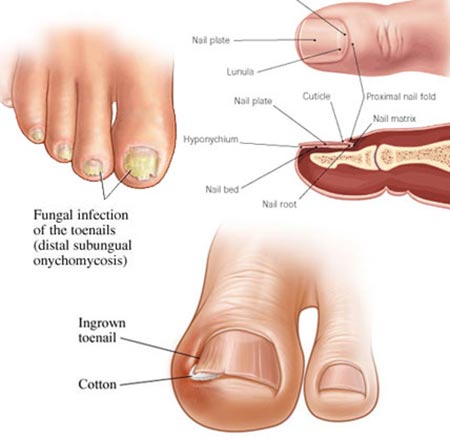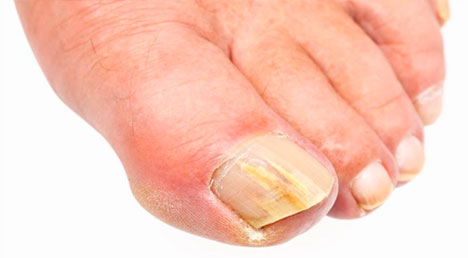Toenail Fungus
 Many people in the United States have been affected by toenail fungus and believe it is something that they have to live with for the rest of their lives. This is simply not true. Your local Manhattan podiatrist offers several prescription treatments that can cure this unsightly infection. Schedule a visit with our doctor to find the right treatment for you. All symptoms should always be evaluated with a thorough consultation and examination by your podiatrist for an accurate diagnosis and treatment plan to exclude any underlying serious condition. Your podiatrist offers a number of prescription treatments that can cure this unsightly infection.
Many people in the United States have been affected by toenail fungus and believe it is something that they have to live with for the rest of their lives. This is simply not true. Your local Manhattan podiatrist offers several prescription treatments that can cure this unsightly infection. Schedule a visit with our doctor to find the right treatment for you. All symptoms should always be evaluated with a thorough consultation and examination by your podiatrist for an accurate diagnosis and treatment plan to exclude any underlying serious condition. Your podiatrist offers a number of prescription treatments that can cure this unsightly infection.
”
★ ★ ★ ★ ★I came in for a consultation for an issue I’ve been having with my stomach for about 2 months. Dr. Yakubov was very kind, informative and made me feel at ease about my current situation. He really took his time to explain to me what the issue could be and answered all of my questions and concerns. The office is very beautiful and clean as well.
Manhattan Foot Doctor Advice
Nail fungus, also called tinea unguium or onychomycosis, is considered a cosmetic issue by many but sometimes a thickened nail can create pressure and subsequently Toe pain and blisters. Thickened fungal nails can also dig into the surrounding skin, causing an ingrown nail in need of evaluation by our Podiatrists, a Manhattan foot doctor. You may be advised to try some self-care techniques to treat the toenail fungus condition if it becomes more uncomfortable such as applying tea tree oil.
If the fungus starts to affect the skin in between your toes your Manhattan foot doctor may diagnose you with athlete’s foot. While athlete’s foot is easily treatable, toenail fungus entails a more lengthy and involved treatment.
Common signs you have a fungal nail are:
- The nail becomes discolored
- Your nail begins to crumble along the edges
- The affected nail becomes thicker and more difficult to trim
- Your nails lose their shine and appear dull
- The shape of your nails is distorted
 Damage to your nail like dropping a box on your toe or dancing in ballet (point) shoes is proven to increase your risk of contracting nail fungus.
Damage to your nail like dropping a box on your toe or dancing in ballet (point) shoes is proven to increase your risk of contracting nail fungus.
Other Apparent Symptoms
Sometimes foul odors are present due to fungus getting trapped under your nail. Damage to your nail like dropping a box on your toe or dancing in ballet (point) shoes is proven to increase your risk of contracting nail fungus. If you find yourself with these symptoms visit the best podiatrist to treat your toenail fungus with the most up-to-date technology and medication
If you have diabetes, is vital that you visit your Manhattan foot doctor when you notice any symptoms of nail fungus. Diabetics frequently get infections by cutting themselves while trying to trim difficult thick nails.
Fungal Infections
Fungi are living, microscopic organisms that don’t need any light to survive. The most common type of fungus that lead to toenail problems are called dermatophyte fungi — although mold and yeast also can cause toenail fungus.
While some fungi are beneficial to your body, the best NY podiatrist explains that fungi:
- Can lead to serious problems when they grow under your toenails
- Like wet and warm environments such as locker rooms and swimming pools
- Can get under your skin through even the tiniest of openings
- Are more likely to grow under your toenails rather than your fingernails, although fingernail fungus can occur
- Enjoy the dark, moist, warm setting of your toes when they’re in shoes and socks
- Are more difficult for your body’s immune system to attack when they grow on your toes because of the decreased blood flow.
Diagnosis: Fungus
Your Manhattan foot doctor first examines your feet visually for signs of fungus. A piece of nail can be sampled and sent for lab testing to confirm if fungus is growing in the nail.
The top New York City podiatrist works to find out which kind of fungus is causing your issues to determine the appropriate toenail fungus treatment. Sometimes conditions such as psoriasis can look like toenail fungus. According to the American Podiatric Medical Association, it’s important that you visit the NYC foot doctor and not try to diagnose yourself. Self-diagnosis of even a seemingly simple thing like toenail fungus can lead to more serious complications that could include:
- Permanent nail damage
- More serious infections
- Development of skin infections such as cellulitis
High Risk Factors
Taking care of your feet and practicing good foot hygiene is an important part of preventing toenail fungus, according to your Manhattan foot doctor. When your feet are dry and clean, they’re best equipped to fight off infections.
Certain factors, however, put you at a greater risk of developing toenail issues that could result in a visit to a leading NYC podiatrist:
- Your age, as older people have a decreased blood flow and nails that grow slower
- A live-in partner or family member that has toenail fungus
- Sweaty feet
- Working in a moist, warm environment like behind a bar or in housekeeping
- Wearing shoes and socks that don’t allow any ventilation to your feet
- Getting athlete’s foot
- Use of locker rooms showers
Reduce your risk by following the suggestions from the best podiatrists in New York:
- Buy socks with wicking properties that are made of synthetic materials
- Wear shoes in the shower when using public facilities
- Dry your feet thoroughly after washing them completely
- Clip your toenails in a straight line, not curved with the shape of your toe
- Disinfect the tools you use on your toes, like toenail clippers
- Don’t share your toenail tools
- Change your socks frequently throughout the day
- Wear breathable shoes
- Stay away from tight hosiery
 Thickened fungal nails can also dig into the surrounding skin, causing an ingrown nail. Your Manhattan foot doctor recommends against self-care when nail fungus is first suspected.
Thickened fungal nails can also dig into the surrounding skin, causing an ingrown nail. Your Manhattan foot doctor recommends against self-care when nail fungus is first suspected.
Fungal Nail Treatments
If everything suggested by your Manhattan foot doctor doesn’t work, you may be a candidate for more aggressive toenail fungus treatment that may include:
- Minimally-invasive surgery to remove the nail
- Oral prescription antifungal drugs
- Medicated cream for your nails
- Nail polish that’s specially medicated
Important Reminder: This information is only intended to provide guidance, not definitive medical advice. Please consult foot doctor about your specific condition. Only a trained, experienced board certified podiatrist or foot specialist can determine an accurate diagnosis and proper treatment.
Do you have any questions about Toenail Fungus treatment in NYC? Would you like to schedule an appointment with an internationally recognized, top NYC Podiatrist and foot doctor at Manhattan Podiatry? Please contact our office for consultation.
In The Press

Call now to make an appointment with our award winning, board certified NYC podiatrists regarding your health. We look forward to seeing you!
book online now (212) 389-9918(212) 389-1886 Podiatrist (Midtown) 51 East 25th Street, Ste 451, NY 10010
(212) 389-1887 Podiatrist (Union Square) 55 W 17th St Ste 106, NY 10011
(212) 378-9991
